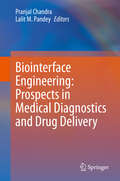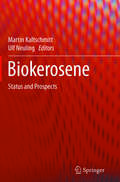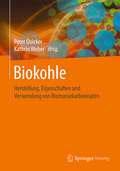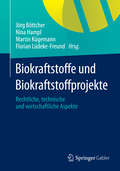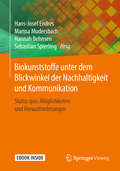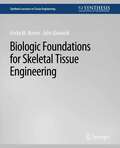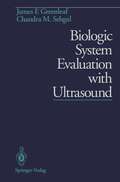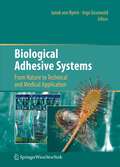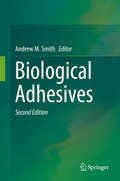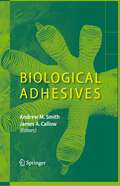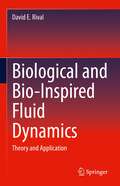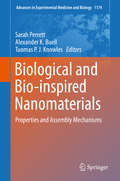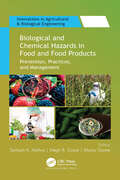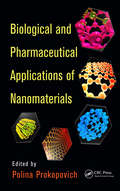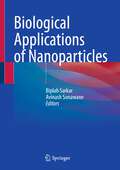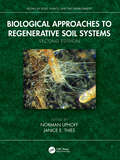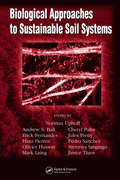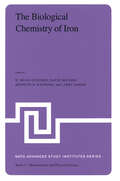- Table View
- List View
Biointerface Engineering: Prospects in Medical Diagnostics and Drug Delivery
by Pranjal Chandra Lalit M. PandeyThis book provides detailed information on the surface and surface chemistry of various biointerfaces for the understanding and development of biosensors, biocompatible devices, and drug delivery systems. It highlights the role of interfacial phenomena towards the behaviour of biomolecules on different surfaces and their significance in recent applications. The book also addresses various surface engineering techniques for the modification of biomaterials that are implemented for improving biocompatibility. It provides an updated scientific concept of various interactions of biological systems with surfaces/modified surfaces at the molecular and cellular level. The chapters include various in-vitro, in-vivo, ex-vivo models to illustrate various aspects of Biointerface Engineering. Finally, the book elucidates troubleshooting strategies and future prospects of Biointerface Engineering in Medical Diagnostics and Drug Delivery.
Biokerosene: Status and Prospects
by Martin Kaltschmitt Ulf NeulingThis book provides a detailed overview of aspects related to the overall provision chain for biokerosene as part of the global civil aviation business. Starting with a review of the current market situation for aviation fuels and airplanes and their demands, it then presents in-depth descriptions of classical and especially new types of non-edible biomass feedstock suitable for biokerosene provision. Subsequent chapters discuss those fuel provision processes that are already available and those still under development based on various biomass feedstock materials, and present e.g. an overview of the current state of the art in the production of a liquid biomass-based fuel fulfilling the specifications for kerosene. Further, given the growing interest of the aviation industry and airlines in biofuels for aviation, the experiences of an air-carrier are presented. In closing, the book provides a market outlook for biokerosene. Addressing a broad range of aspects related to the pros and cons of biokerosene as a renewable fuel for aviation, the book offers a unique resource.
Biokohle: Herstellung, Eigenschaften und Verwendung von Biomassekarbonisaten
by Dennis Blöhse Thomas Echterhof Sabrina Eichenauer Simone Heger Claudia Kammann Andrea Kruse Peter Quicker Marc-André Schulten Christoph Sager Saulo Seabra Klaus Serfass Ernst Stadlbauer Kathrin WeberBiomassekarbonisate (Biokohlen) besitzen signifikant unterschiedliche Eigenschaften, die von den Herstellungsverfahren, Prozessbedingungen und Ausgangssubstraten abhängen. Im Buch sind die technisch verfügbaren Verfahren zur Erzeugung von Biokohle beschrieben und die thermochemischen Prozesse erörtert. Anhand von zahlreichen farbigen Abbildungen sind die Prozesse, Eigenschaften und Einsatzmöglichkeiten veranschaulicht. Der Fokus des Buches liegt auf den großtechnischen Anwendungen als Energieträger, als Reduktions- oder Aufkohlungsmittel in metallurgischen Verfahren, in Recyclingprozessen oder in Kraft- und Zementwerken. Aber auch die Anwendung von Biomassekarbonisaten in der Landwirtschaft als Bodenhilfsstoff oder in der Tierhaltung ist aufgezeigt.
Biokraftstoffe und Biokraftstoffprojekte: Rechtliche, technische und wirtschaftliche Aspekte
by Jörg Böttcher Nina Hampl Martin Kügemann Florian Lüdeke-FreundDieses Buch beschäftigt sich mit Biokraftstoffen und Biokraftstoffprojekten. Die Autoren zeigen auf, welche rechtlichen, agrarischen, ökologischen und ökonomischen Rahmenbedingungen von Biokraftstoffen beachtet werden müssen. Die Betrachtung dieser Rahmenbedingungen und weiterer – eher anlagenbezogener – Faktoren ermöglicht es dann, Rückschlüsse auf die Realisierung von Biokraftstoffvorhaben zu ziehen. Besonderes Augenmerk wird dabei auf den sensiblen Themenkomplex der Nachhaltigkeit von Biokraftstoffen gerichtet. Die anhaltende Diskussion unerwünschter sozialer, ökologischer und ökonomischer Effekte hat zu neuen und bislang nicht abschließend definierten gesellschaftlichen und politischen Ansprüchen an die Biokraftstoffindustrie geführt.
Biokunststoffe unter dem Blickwinkel der Nachhaltigkeit und Kommunikation: Status quo, Möglichkeiten und Herausforderungen
by Hans-Josef Endres Marina Mudersbach Hannah Behnsen Sebastian SpierlingDas Buch zeigt, wie eine Nachhaltigkeitsbewertung von Biokunststoffen gelingen kann und wie die Ergebnisse einer solchen Bewertung ausfallen. Es analysiert die öffentliche Wahrnehmung beim Verbraucher sowie die politischen Rahmenbedingungen von Biokunststoffen.
Biologic Foundations for Skeletal Tissue Engineering (Synthesis Lectures on Tissue Engineering)
by Ericka Bueno Julie GlowackiTissue engineering research for bone and joint applications entails multidisciplinary teams bringing together the needed expertise in anatomy, biology, biochemistry, pathophysiology, materials science, biomechanics, fluidics, and clinical and veterinary orthopedics. It is the goal of this volume to provide students and investigators who are entering this exciting area with an understanding of the biologic foundations necessary to appreciate the problems in bone and cartilage that may benefit from innovative tissue engineering approaches. This volume includes state-of-the-art information about bone and cartilage physiology at the levels of cell and molecular biology, tissue structure, developmental processes, their metabolic and structural functions, responses to injury, mechanisms of post-natal healing and graft incorporation, the many congenital and acquired disorders, effects of aging, and current clinical standards of care. It reviews the strengths and limitations of various experimental animal models, sources of cells, composition and design of scaffolds, activities of growth factors and genes to enhance histogenesis, and the need for new materials in the context of cell-based and cell-free tissue engineering. These building blocks constitute the dynamic environments in which innovative approaches are needed for addressing debilitating disorders of the skeleton. It is likely that a single tactic will not be sufficient for different applications because of variations in the systemic and local environments. The realizations that tissue regeneration is complex and dynamic underscore the continuing need for innovative multidisciplinary investigations, with an eye to simple and safe therapies for disabled patients. Table of Contents: Introduction / Structure and Function of Bone and Cartilage Tissue / Development / Responses to Injury and Grafting / Clinical Applications for Skeletal Tissue Engineering / Animal Models / Tissue Engineering Principles for Bone and Cartilage / Perspectives
Biologic System Evaluation with Ultrasound
by James F. Greenleaf Chandra M. SehgalBiologic System Evaluation with Ultrasound is a reference book for engineers in the field of ultrasonics and is intended to inform those unfamiliar with current methods of ultrasonic analysis. Explaining the mathematical and physical principles of ultrasound imaging of living tissue with effective precision, the book encompasses the following topics: relationships between the biological and scattering hierarchies; graphic description of scattering; class 1,2,3,4 scattering and their association with the biological hierarchy; instruments used for biologic system evaluation; computed tomographic methods of imaging. The authors have provided an effective explanation of the ultrasound scattering of image and image acquisition that will benefit engineers, physicists, and radiologists alike.
Biological Adhesive Systems: From Nature to Technical and Medical Application
by Janek Byern Ingo GrunwaldJ. Herbert Waite Like many graduate students before and after me I was There are so many species about which nothing is known, mesmerized by a proposition expressed years earlier by and the curse of not knowing is apathy. Krogh (1929) – namely that “for many problems there is Bioadhesion is the adaptation featured in this book, an animal on which it can be most conveniently studied”. and biology has many adhesive practitioners. Indeed, This opinion became known as the August Krogh Prin- every living organism is adhesively assembled in the ciple and remains much discussed to this day, particu- most exquisite way. Clearly, speci? c adhesion needs to larly among comparative physiologists (Krebs, 1975). be distinguished from the opportunistic variety. I think The words “problems” and “animal” are key because of speci? c adhesion as the adhesion between cells in the they highlight the two fundamental and complementary same tissue, whereas opportunistic adhesion might be the foci of biological research: (1) expertise about an animal adhesion between pathogenic microbes and the urinary (zoo-centric), which is mostly observational and (2) a tract, or between a slug and the garden path. If oppor- mechanistic analysis of some problem in the animal’s life nistic bioadhesion is our theme, then there are still many history or physiology (problem-centric), which is usually practitioners but the subset is somewhat more select than a hypothesis-driven investigation. before.
Biological Adhesives
by Andrew M. SmithMany creatures use adhesive polymers and structures to attach to inert substrates, to each other, or to other organisms. This is the first major review that brings together research on many of the well-known biological adhesives dealing with bacteria, fungi, algae, and marine and terrestrial animals. As we learn more about their molecular and mechanical properties we begin to understand why they adhere so well and with this comes broad applications in areas such as medicine, dentistry, and biotechnology.
Biological Adhesives
by Andrew M. Smith James A. CallowMany creatures use adhesive polymers and structures to attach to inert substrates, to each other, or to other organisms. This is the first major review that brings together research on many of the well-known biological adhesives dealing with bacteria, fungi, algae, and marine and terrestrial animals. As we learn more about their molecular and mechanical properties we begin to understand why they adhere so well and with this comes broad applications in areas such as medicine, dentistry, and biotechnology.
Biological and Bio-Inspired Fluid Dynamics: Theory and Application
by David E. RivalThis text provides the reader with tools necessary to study biological and bio-inspired flows, all the while developing an appreciation for their evolutionary and engineering constraints. It is suitable for students already exposed to introductory concepts in fluid mechanics and applied mechanics as a whole, but who would not need an advanced training in fluid mechanics per se. Currently no textbook exists that can take students from an introductory position in fluid mechanics to these contemporary topics of interest. The book is ideal for upper-level undergraduates and graduate students studying a range of engineering domains as well as biology, or even medicine.
Biological and Bio-inspired Nanomaterials: Properties and Assembly Mechanisms (Advances in Experimental Medicine and Biology #1174)
by Sarah Perrett Alexander K. Buell Tuomas P. J. KnowlesThis book summarizes naturally occurring and designed bio-inspired molecular building blocks assembled into nanoscale structures. It covers a fascinating array of biomimetic and bioinspired materials, including inorganic nanozymes, structures formed by DNA origami, a wide range of peptide and protein-based nanomaterials, as well as their applications in diagnostics and therapeutics. The book elucidates the mechanism of assembly of these materials and characterisation of their mechanical and physico-chemical properties which inspires readers not only to exploit the potential applications of nanomaterials, but also to understand their potential risks and benefits. It will be of interest to a broad audience of students and researchers spanning the disciplines of biology, chemistry, engineering, materials science, and physics.
Biological and Chemical Hazards in Food and Food Products: Prevention, Practices, and Management (Innovations in Agricultural & Biological Engineering)
by Santosh K. Mishra Megh R. Goyal Manju GaareThis volume takes an in-depth look at various biological and chemical hazards in food and food products that pose health threats. It also outlines methods and practices for the diagnosis, prevention, and management of these hazards in food production processes. The new scientific research and case studies presented in the volume cover mycotoxins, foodborne pathogens, antibiotic residues from dairy animals, pesticide residues, the presence of heavy metals in food, and more. Chapters also address food allergy management and offer lessons and practices in food recall situations. The authors discuss the various food toxins, their sources, as well as management, mitigation, and prevention strategies. Also addressed are the specific adverse effects on people with health problems such as diabetes, hypertension, cancer, neurodegenerative diseases, and more. This book is organized in such a way that each chapter treats one major food safety hazard and offers novel control methods for health, food safety, and quality enhancement through various means. Biological and Chemical Hazards in Food and Food Products: Prevention, Practices, and Management will aid researchers and policymakers as it illustrates the various aspects of food safety hazards and how to analyze and control these potential health threats.
Biological and Chemical Hazards in Food and Food Products: Prevention, Practices, and Management (Innovations in Agricultural & Biological Engineering)
by Santosh K. Mishra, Megh R. Goyal and Manju GaareThis volume takes an in-depth look at various biological and chemical hazards in food and food products that pose health threats. It also outlines methods and practices for the diagnosis, prevention, and management of these hazards in food production processes. The new scientific research and case studies presented in the volume cover mycotoxins, foodborne pathogens, antibiotic residues from dairy animals, pesticide residues, the presence of heavy metals in food, and more. Chapters also address food allergy management and offer lessons and practices in food recall situations. The authors discuss the various food toxins, their sources, as well as management, mitigation, and prevention strategies. Also addressed are the specific adverse effects on people with health problems such as diabetes, hypertension, cancer, neurodegenerative diseases, and more. This book is organized in such a way that each chapter treats one major food safety hazard and offers novel control methods for health, food safety, and quality enhancement through various means. Biological and Chemical Hazards in Food and Food Products: Prevention, Practices, and Management will aid researchers and policymakers as it illustrates the various aspects of food safety hazards and how to analyze and control these potential health threats.
Biological and Hybrid Wastewater Treatment Technology: Recent Developments in India (Earth and Environmental Sciences Library)
by Shalini Yadav Ram Narayan Yadava Makarand M. GhangrekarThis book provides technical information on different biological and hybrid wastewater treatment systems for the treatment of wastewater and reuse, and tracks their progress towards practical and field-scale applications including strategies to be adopted for minimizing the losses and maximizing the benefits, as well as protecting the environment through the application of advanced biological and hybrid wastewater treatment Technology. In addition, it discusses the crucial parts that science, technology, and innovation play in the formulation, implementation, and administration of wastewater treatment policy. It highlights the challenges that must be overcome to adopt biological and hybrid wastewater treatment infrastructure regulations successfully and provides some answers. Also, it investigates how the biological and hybrid wastewater treatment technology may be used in a wide variety of field's sets apart from other on-the-shelf publications on the market. Also, it delves into the core concepts of Biological and Hybrid Wastewater Treatment Systems. It explores how these concepts can be modified to fit a variety of contexts and uses. Applications such as managing facilities, dealing with pandemics, urban wastewater treatment and reuse, farming, and other applications are included in this book. As a consequence, this book's content is engaging, and it will pique the interest of a diverse audience of readers who come from a wide variety of different professional backgrounds. Therefore, the book is written by local experts in the topic who dealing with the treatment of wastewater treatment technologies for a long time in India. This book will be helpful to researchers, entrepreneurs, professionals, planners, policymakers, environmental engineers, and others interested in biological and hybrid wastewater treatment system management strategies through the application of breakthroughs in biological and hybrid wastewater treatment technologies.
Biological and Medical Aspects of Electromagnetic Fields, Fourth Edition (Handbook of Biological Effects of Electromagnetic Fields)
by Ben Greenebaum Frank BarnesThe two volumes of this new edition of the Handbook cover the basic biological, medical, physical, and electrical engineering principles. They also include experimental results concerning how electric and magnetic fields affect biological systems—both as potential hazards to health and potential tools for medical treatment and scientific research. They also include material on the relationship between the science and the regulatory processes concerning human exposure to the fields. Like its predecessors, this edition is intended to be useful as a reference book but also for introducing the reader to bioelectromagnetics or some of its aspects. FEATURES • New topics include coverage of electromagnetic effects in the terahertz region, effects on plants, and explicitly applying feedback concepts to the analysis of biological electromagnetic effects • Expanded coverage of electromagnetic brain stimulation, characterization and modeling of epithelial wounds, and recent lab experiments on at all frequencies • Section on background for setting standards and precautionary principle • Discussion of recent epidemiological, laboratory, and theoretical results; including: WHO IARC syntheses of epidemiological results on both high and low frequency fields, IITRI lab study of cancer in mice exposed to cell phone-like radiation, and other RF studies • All chapters updated by internationally acknowledged experts in the field
Biological and Medical Aspects of Electromagnetic Fields, Fourth Edition (Handbook of Biological Effects of Electromagnetic Fields)
by Ben Greenebaum Frank BarnesThe two volumes of this new edition of the Handbook cover the basic biological, medical, physical, and electrical engineering principles. They also include experimental results concerning how electric and magnetic fields affect biological systems—both as potential hazards to health and potential tools for medical treatment and scientific research. They also include material on the relationship between the science and the regulatory processes concerning human exposure to the fields. Like its predecessors, this edition is intended to be useful as a reference book but also for introducing the reader to bioelectromagnetics or some of its aspects. FEATURES • New topics include coverage of electromagnetic effects in the terahertz region, effects on plants, and explicitly applying feedback concepts to the analysis of biological electromagnetic effects • Expanded coverage of electromagnetic brain stimulation, characterization and modeling of epithelial wounds, and recent lab experiments on at all frequencies • Section on background for setting standards and precautionary principle • Discussion of recent epidemiological, laboratory, and theoretical results; including: WHO IARC syntheses of epidemiological results on both high and low frequency fields, IITRI lab study of cancer in mice exposed to cell phone-like radiation, and other RF studies • All chapters updated by internationally acknowledged experts in the field
Biological and Pharmaceutical Applications of Nanomaterials
by Polina ProkopovichBiological and Pharmaceutical Applications of Nanomaterials presents the findings of cutting-edge research activities in the field of nanomaterials, with a particular emphasis on biological and pharmaceutical applications. Divided into four sections-nanomaterials for drug delivery, antimicrobial nanomaterials, nanomaterials in biosensors, and safet
Biological and Synthetic Polymer Networks
by O. KramerBiological and Synthetic Polymer Networks contains 36 papers selected from the papers presented at NETWORKS 86, the 8th Polymer Networks Group Meeting. NETWORKS 86 was held in Elsinore, Denmark, on 31 August 5 September 1986. A total of nine invited main lectures and 68 contributed papers were presented at the meeting. A wide range of important biological and synthetic materials consist of three-dimensional polymer networks. The properties range from very stiff structural materials to extremely flexible rubbery materials and gels. Most polymer networks are permanent networks held together by covalent bonds. Such networks are insoluble but they may swell considerably in good solvents. Polymer networks held together by ionic bonds, hydrogen bonds or so-called entanglements are of a more temporary nature. At long times they exhibit a tendency to flow, and they are soluble in good solvents. The paper by Professor Walther Burchard and his co-workers, 'Covalent, Thermoreversible and Entangled Networks: An Attempt at Comparison', serves as a general introduction to polymer networks. The book contains both theoretical and experimental papers on the formation, characterisation and properties of polymer networks. Two topics were given special sessions at the meeting, namely Biological Networks and Swelling of Polymer Networks.
Biological Antenna to the Humanoid Bot: Electromagnetic Resonances in Biomaterials (Studies in Rhythm Engineering)
by Kanad Ray Anirban Bandyopadhyay Pushpendra SinghThe book outlines a pathway to the development of fusion of electromagnetic resonance and artificial intelligence which will dominate the world of communication engineering. Electromagnetic resonance is fundamental to all biomaterials. The authors explore the peculiarities of this typical resonance behaviour in the literatures and provide the key points where the research should direct. Biological antennas are inspiring designing of several electromagnetic devices. From biomimetic engineering to humanoid bots a revolution is undergoing. Authors include entire development in the form of a book along with their contribution to this field.
Biological Applications of Nanoparticles
by Biplab Sarkar Avinash SonawaneThis textbook for graduate and postgraduate students provides comprehensive applications of nanoparticles in medicine, agriculture, and environmental sciences. The initial chapter covers basic topics related to types, synthesis, structure, and properties of various nanoparticles. It further discusses the wide range of applications of nanoparticles in medicine, agriculture, and the environment. The book presents nano-electronic biosensors that are used to diagnose and monitor the progression of human diseases. It summarizes the opportunities and challenges of nanotechnology in the agriculture and food sector highlighting the scientific, technical, regulatory, safety, and societal impacts. Additionally, it illustrates the applications of nanotechnology in the field of aquaculture medicine, bioinformatics and food technology. The textbook examines the development and administration of nano-medicines , their applications, advantages, and limitations for the treatment and prophylaxis of a broad range of diseases. Lastly, the textbook explores the recent advances in the field of nanobusiness and nanotechnology issues in intellectual property management( IPR).
Biological Approaches to Regenerative Soil Systems (Books in Soils, Plants, and the Environment)
by Norman Uphoff Janice E. Thies Andrew S. Ball Febri Doni Olivier Husson Mark Laing David Montgomery Radha Prasanna Jules Pretty Odo Primavesi Stephen WoodAgriculture in the 21st century will need considerable modification to remain both productive and sustainable. Greater production is needed to meet the needs of our still-growing populations and to combat hunger and poverty. Declines in soil health and the pollution of water sources are making many of our production systems less tenable. These adverse trends are exacerbated more and more by the impacts of climate change. There are, fortunately, alternative methods available for agricultural practice that can countervail these constraints. Biological Approaches to Regenerative Soil Systems brings together the work of both researchers and practitioners to map out better approaches to contemporary agriculture that draw upon both old and new knowledge. It presents the science that underlies more biologically driven strategies as well as contemporary innovative experiences in diverse parts of the world. Both accepted research and these varied experiences encourage confidence that these approaches, not relying primarily on the introduction of new varieties and on exogenous inputs, can succeed. This book updates and revises a preceding volume Biological Approaches to Sustainable Soil Systems published by CRC Press in 2006. So much has been learned and done on this subject in the past decade and a half that a second edition was warranted. For instance, the first edition was published, knowledge about plant-soil microbiomes, which are a frequent focus in this book, has mushroomed. Because sustainability is a broad term and an end-state, the editors preferred to assemble expertise regarding regenerative agriculture, which is concerned with the means for achieving sustainability. The concept of regenerative soil systems, entities that are more complex and multifaceted than "soil" alone, also incorporates a concern with having more resilient agricultural systems, ones that are better able to cope with the multiple stresses of climate change that are foreseen for the decades ahead. The book’s chapters representing a wide range of disciplines were contributed by 84 scientists and practitioners from 20 countries. Although they come from persons with in-depth knowledge of their respective fields, the chapters are written to be accessible to readers who are not trained in the specialized subjects. Taken together, the chapters provide students, researchers, practitioners, planners, and policy makers with a comprehensive understanding of both the science and the steps needed to regenerate and sustain soil systems around the world for the long-term benefit of humankind and the environment.
Biological Approaches to Regenerative Soil Systems (Books in Soils, Plants, and the Environment)
Agriculture in the 21st century will need considerable modification to remain both productive and sustainable. Greater production is needed to meet the needs of our still-growing populations and to combat hunger and poverty. Declines in soil health and the pollution of water sources are making many of our production systems less tenable. These adverse trends are exacerbated more and more by the impacts of climate change. There are, fortunately, alternative methods available for agricultural practice that can countervail these constraints. Biological Approaches to Regenerative Soil Systems brings together the work of both researchers and practitioners to map out better approaches to contemporary agriculture that draw upon both old and new knowledge. It presents the science that underlies more biologically driven strategies as well as contemporary innovative experiences in diverse parts of the world. Both accepted research and these varied experiences encourage confidence that these approaches, not relying primarily on the introduction of new varieties and on exogenous inputs, can succeed. This book updates and revises a preceding volume Biological Approaches to Sustainable Soil Systems published by CRC Press in 2006. So much has been learned and done on this subject in the past decade and a half that a second edition was warranted. For instance, the first edition was published, knowledge about plant-soil microbiomes, which are a frequent focus in this book, has mushroomed. Because sustainability is a broad term and an end-state, the editors preferred to assemble expertise regarding regenerative agriculture, which is concerned with the means for achieving sustainability. The concept of regenerative soil systems, entities that are more complex and multifaceted than "soil" alone, also incorporates a concern with having more resilient agricultural systems, ones that are better able to cope with the multiple stresses of climate change that are foreseen for the decades ahead. The book’s chapters representing a wide range of disciplines were contributed by 84 scientists and practitioners from 20 countries. Although they come from persons with in-depth knowledge of their respective fields, the chapters are written to be accessible to readers who are not trained in the specialized subjects. Taken together, the chapters provide students, researchers, practitioners, planners, and policy makers with a comprehensive understanding of both the science and the steps needed to regenerate and sustain soil systems around the world for the long-term benefit of humankind and the environment.
Biological Approaches to Sustainable Soil Systems
by Norman Uphoff Pedro Sanchez Nteranya Sanginga Janice Thies Andrew S. Ball Erick Fernandes Hans Herren Olivier Husson Mark Laing Cheryl Palm Jules PrettyGlobal agriculture is now at the crossroads. The Green Revolution of the last century is losing momentum. Rates of growth in food production are now declining, with land and water resources becoming scarcer, while world population continues to grow. We need to continue to identify and share the knowledge that will support successful and sustainable
The Biological Chemistry of Iron: A Look at the Metabolism of Iron and Its Subsequent Uses in Living Organisms Proceedings of the NATO Advanced Study Institute held at Edmonton, Alberta, Canada, August 13 – September 4, 1981 (Nato Science Series C: #89)
by B. H. Dunford D. Dolphin K. N. Raymond L. SiekerThe results of a NATO Advanced Study Institute (ASI) entitled "Coordination Chemistry Environments in Iron-Containing Proteins and Enzymes - Including Smaller Molecules and Model Systems" are summarized in this book. The ASI was held in the Province of Alberta, Canada, from August 23 to September 4, 1981. The first half of the conference was held on the campus of the University of Alberta, Edmonton, and the second half at the Overlander Lodge, Hinton. Two other conferences had the greatest impact upon the planning for this ASI. One was a NATO ASI held in Tomar, Portugal in September of 1979, entitled "Metal Ions in Biology". Among the organizers for that conference were Allen Hill and Antonio Xavier; we are happy to acknowledge their beneficial influence on our subsequent conference. The other most influential conference was one organized by Ralph Wilkins and Dennis Darnell entitled "Methods for Determining Metal Ion Environments in Proteins" which was held in Las Cruces, New Mexico, U.S.A., January 10-12, 1979. The Las Cruces conference invited lectures were published as Volume 2 of "Advances in Inorganic Biochemistry", G. Eichhorn and L. Marzilli, editors.
